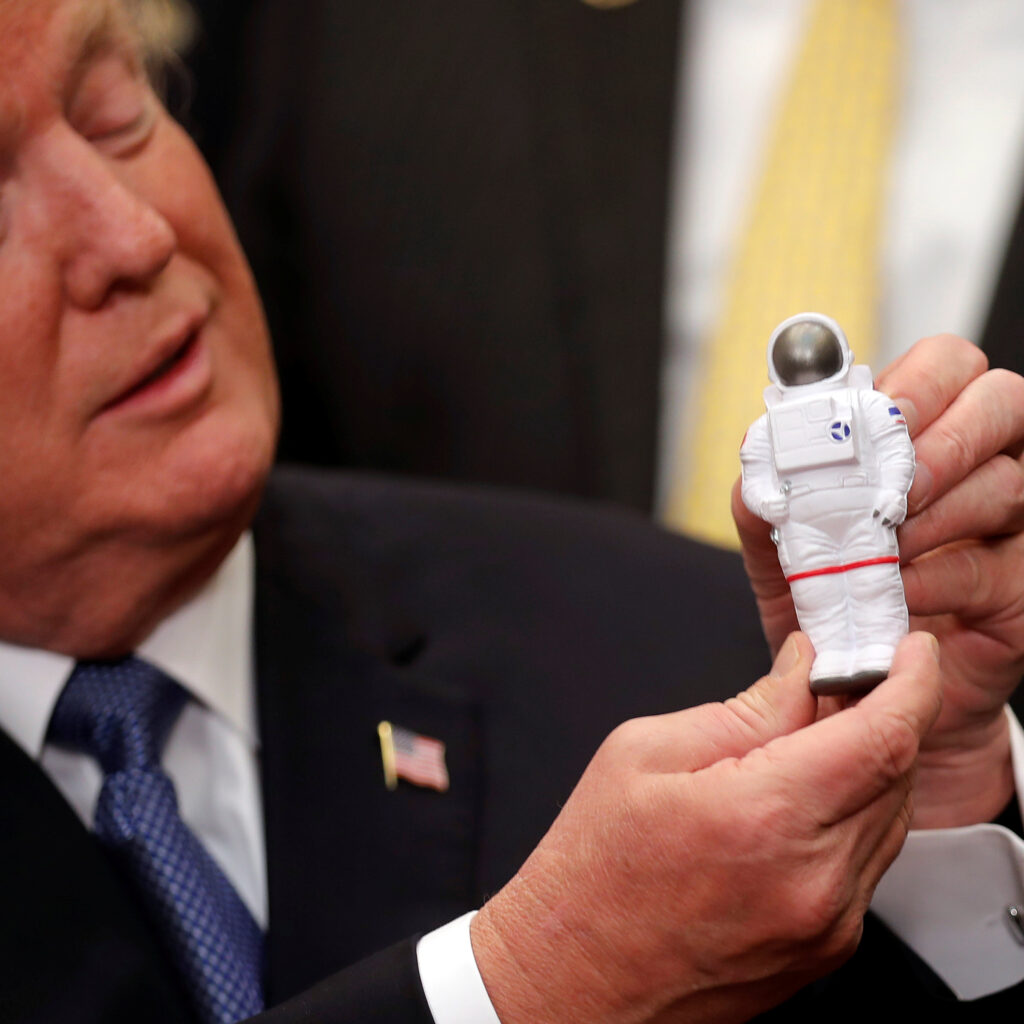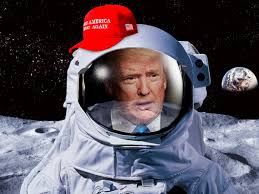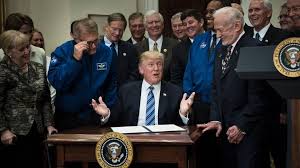During his time as the 45th President of the United States (2017-2021), Donald Trump played a significant role in shaping the country’s space policy, having a lasting impact on NASA’s space operations, astronauts’ missions, and U.S. space exploration initiatives. His administration’s decisions affected the strategic direction of NASA’s human spaceflight programs, most notably the Artemis program, which focuses on returning astronauts to the Moon and preparing for missions to Mars. Trump’s policies also influenced the roles private companies like SpaceX began to play in U.S. space efforts, creating an intersection of public and private sector collaboration in the world of space exploration.
Space Policy Initiatives under Trump

Trump’s space policy was shaped by a desire to strengthen U.S. leadership in space and to reduce reliance on foreign countries, particularly for crewed spaceflight. One of his first actions was to re-establish the National Space Council in 2017. The National Space Council was revived to help coordinate and lead U.S. space policy, with Vice President Mike Pence serving as its chairman. This was seen as a step to realign the country’s space priorities and increase coordination between NASA, the military, and the private sector.
In 2017, Trump’s administration also passed Space Policy Directive 1, which called for a return of humans to the Moon and a broader vision for sending astronauts to Mars. This policy shifted the focus from robotic missions to deep space exploration, which had previously dominated NASA’s agenda. The directive emphasized the importance of partnering with private space companies, like SpaceX, to reduce the cost of space missions and make space exploration more accessible.
The Artemis Program: A Vision for the Future

One of the most significant legacies of Trump’s space policy is the Artemis program, named after the Greek goddess of the Moon. Artemis aims to return American astronauts to the Moon by 2024, with a focus on establishing a sustainable lunar presence. This program aligns with Trump’s vision for human exploration beyond Earth and is seen as a stepping stone for eventual human missions to Mars.
While the Artemis program officially began under Trump’s administration, its scope and objectives were largely in place when NASA Administrator Jim Bridenstine and the space agency leadership set the ambitious goals. The Artemis mission is part of a broader vision to demonstrate the U.S.’s capacity to lead in space exploration, build the necessary infrastructure for human space missions, and advance technological innovations that will pave the way for future exploration of the solar system.
Astronauts’ Missions During Trump’s Presidency

Under the Trump administration, NASA astronauts had several landmark missions that pushed the boundaries of space exploration. In particular, Trump’s policies on space exploration allowed for closer collaborations between NASA and commercial space companies like SpaceX, whose Crew Dragon spacecraft played a key role in transporting astronauts to and from the International Space Station (ISS).
One of the most notable milestones was the historic launch of NASA astronauts Robert Behnken and Douglas Hurley aboard SpaceX’s Crew Dragon capsule in May 2020. This mission, known as Demo-2, was the first crewed mission launched by a private company to the ISS and was a major achievement for both NASA and SpaceX. It marked the beginning of regular crewed missions through NASA’s Commercial Crew Program, allowing the U.S. to regain its ability to send astronauts into space from American soil since the end of the Space Shuttle program in 2011.
The success of the Crew Dragon missions furthered the role of private companies in space exploration and set the stage for future space missions involving astronauts. These missions signified a new era of space travel, where government space agencies and private entities could work hand in hand to accomplish ambitious goals.
The Rescue of Astronauts Butch Wilmore and Sunita Williams

In 2024, NASA astronauts Barry “Butch” Wilmore and Sunita “Suni” Williams found themselves stranded aboard the International Space Station (ISS) for over nine months after a technical failure in the spacecraft that was supposed to return them to Earth. Originally intended to be a mission lasting just over a week, unforeseen technical difficulties led to the astronauts’ prolonged stay on the ISS.
In response, President Trump voiced public concern over their situation and advocated for the acceleration of their return. The issue was raised in the context of discussions about how such a long stay had not been anticipated under previous administrations. Trump took the opportunity to assert that the success of their safe return was partly due to his administration’s efforts to promote the development of new spacecraft and technologies that enabled SpaceX to perform a rescue mission.
After a prolonged mission, the astronauts were safely returned to Earth in March 2025 as part of SpaceX’s Crew-9 mission. This marked a successful return, drawing public attention to the importance of the collaboration between NASA and private space agencies. Trump, along with other political figures, congratulated the astronauts and commended the resilience and bravery of Wilmore and Williams during their extended mission.
Public Perception and Criticism

The rescue mission and its aftermath became a focal point for public discussion. Trump’s comments on the mission generated significant attention, with some critics accusing him of using the astronauts’ extended stay for political gain, while others praised his leadership in facilitating the collaboration that made the rescue possible. There were claims that previous delays in the mission were rooted in political decision-making that caused unnecessary risks, although NASA officials made it clear that the astronauts’ stay was a result of operational needs and not political interference.
Nonetheless, Trump’s vocal support for the astronauts and his involvement in bringing attention to the mission created a larger-than-life narrative about the U.S. space program, underscoring the increasingly visible role of space exploration in political discourse.
Conclusion

Donald Trump’s presidency had a significant and lasting impact on U.S. space policy, particularly in how the nation engages in space exploration and collaborates with private sector companies. His efforts to reorient NASA’s priorities toward human exploration of the Moon and Mars, alongside the promotion of private sector involvement in space travel, marked a transformative period for space exploration.
The collaboration between NASA and SpaceX under Trump’s leadership helped pave the way for a new era in spaceflight. From the historic Crew Dragon mission to the rescue of astronauts Butch Wilmore and Sunita Williams, Trump’s space policy has left an indelible mark on the future of U.S. space exploration.
As the U.S. prepares for the Artemis missions and the continued development of Mars exploration, the influence of Trump’s space policies will continue to be felt. The increasing role of private companies, technological advancements, and international cooperation all point to a bright future for astronauts and space missions across the globe.
Author Profile
- Syed Tahir Abbas is a Master's student at Southwest University, Chongqing, specializing in international relations and sustainable development. His research focuses on U.S.-China diplomacy, global geopolitics, and the role of education in shaping international policies. Syed has contributed to academic discussions on political dynamics, economic growth, and sustainable energy, aiming to offer fresh insights into global affairs.
Latest entries
 GeopoliticsAugust 23, 2025Previewing the White House Visit of South Korean President Lee Jae Myung
GeopoliticsAugust 23, 2025Previewing the White House Visit of South Korean President Lee Jae Myung Middle East ConflictJuly 22, 2025Israel’s Deadly Attacks on Gaza: A Dire Humanitarian Crisis and International Calls for a Truce
Middle East ConflictJuly 22, 2025Israel’s Deadly Attacks on Gaza: A Dire Humanitarian Crisis and International Calls for a Truce Middle East & North AfricaJuly 20, 2025Israel Targets Damascus Amid Rising Tensions in Syria
Middle East & North AfricaJuly 20, 2025Israel Targets Damascus Amid Rising Tensions in Syria Middle East AffairsJuly 14, 2025An Open Letter from Gaza’s University Presidents: Resisting Scholasticide Through Education
Middle East AffairsJuly 14, 2025An Open Letter from Gaza’s University Presidents: Resisting Scholasticide Through Education


